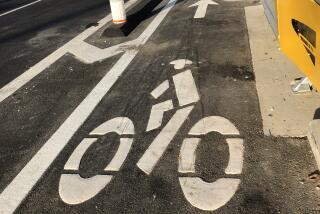Pedaling the eco-commute
Oh, %*$#@! That was pretty much the soundtrack to my daily commute on the iZip Express electric bicycle.
The bike wasn’t the reason I was swearing like a deranged baseball manager. It was the rush-hour traffic. Otherwise, this 750-watt, battery-assisted pedal pusher did exactly what it’s designed to do. It got me out of my car and into a cost-effective, eco-friendly commuter vehicle, and it did it without making me sweat like a sumo wrestler.
The iZip Express is a true hybrid. The direct current neodymium magnet motor operates only when the rider is pedaling. The pedals and motor work together, which is why riding the Express feels like riding a tandem bicycle -- when the other person’s doing more of the work.
I just pushed a button on the 36-volt lithium-ion battery pack to turn on the bike, pushed another button to select the level of power-assist, started spinning and the Express whirred to life. Speeding up and slowing down, I moved through all 27 speeds on the Shimano drive train with a combination of two movements. I twisted the right grip to select among the nine speeds on the freewheel, and I adjusted the tension on those gears with my left -- just like I would on a standard, multispeed bicycle.
What wasn’t normal was the planetary drive system, which combines the power produced from pedaling with the output from the motor -- a system that allowed me to reach higher speeds with less physical effort. In the five days I spent commuting on the iZip Express, my top speed was 32 mph. My heart wasn’t pounding to the point of explosion and sweat wasn’t flying off my face. But at such a fast pace, I did look like Miss Gulch pedaling away in “The Wizard of Oz,” which is why my average speed was more like 15 mph.
That was slow enough that I needed to stay right and scan parked cars for unexpected door openings but fast enough that my 5.75-mile commute was a mere 21 minutes from door to desk. That’s faster than my commute by car or even motorcycle, when I factor in the time it takes to gear up, park, walk to my cubicle and gear down.
What does take time is recharging the battery pack. It takes four to six hours to fully charge the batteries, which the manufacturer says can travel 31 to 62 miles per charge, depending on the power setting. Reading the bike’s level of charge is simple, but it isn’t precise. There are five lighted dots on the battery pack that disappear one by one until you’re out of juice. I found that if I fully charged the bike when I got home and unplugged it before going to sleep, it lost one dot, or one-fifth of its charge, by morning and another one-fifth on my ride to work, but I could get another round trip on the bike before it needed to be plugged in.
Pedaling doesn’t help charge the batteries. Neither does braking. That would require reversing the polarity of the motor to send energy back to the batteries -- a bit of technological wizardry that’s inefficient and offers almost no benefit because the brakes on a bicycle aren’t used nearly as often as they are on a larger, motorized vehicle that’s moving with the whims of traffic.
What’s most efficient about the Express is the cost. It’s about 10 cents to fully charge the bike, which translates to a fraction of a penny per mile to ride it. At $2,999, the bike’s initial cost may seem steep, but the moral superiority I felt when riding it was priceless.
--
--
2008 iZip Express
Base price: $2,999
Powertrain: 750-watt DC neodymium magnet motor; 36-volt 18AH lithium-ion battery back; Dolphin Evo-Drive; Shimano 44/32/22T crank and torque sensor; 27-speed gear train; on-board charger
Top speed: 20-plus mph
Range: 31-62 miles per charge, depending on power setting
Net weight: 60 pounds





